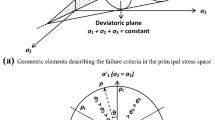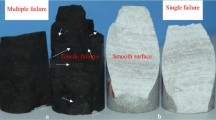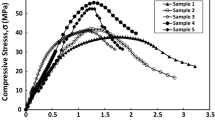Abstract
One of the primary goals of wellbore stability analysis is the estimation of the shear failure onset or borehole breakout. Estimation of borehole shear failure requires selecting an appropriate failure criterion. Numerous failure criteria have been used for rock failure analysis, but there is no common agreement of which criterion to select for wellbore stability analysis. In general, rock failure criteria mainly depend on rock mechanical properties and in situ stresses. This paper investigates the effect of rock strength variation and strength anisotropy on the estimated borehole shear failure using thirteen different criteria. A rock strength database was created from different US unconventional shale plays. Rock failure criteria were ranked based on the estimated borehole breakout for different shales. According to the results for different level of rock strength, there are some failure criteria that are highly responsive to variation in rock mechanical properties. Circumscribed Drucker–Prager, Modified Griffith, Inscribed Drucker–Prager criteria have shown great response to the change in the internal angle of friction. Murrell, Stassi D’Alia, Hoek–Brown, and Griffith are sensitive to variation of uniaxial compressive strength. Mogi-Coulomb, Modified Wiebols–Cook, Modified Lade, and Mohr-Coulomb failure criteria did not show any significant response to the variation of rock mechanical properties and strength anisotropy.











Similar content being viewed by others
References
Aadnoy BS, Chenevert ME (1987) Stability of highly inclined boreholes. J SPE Drill Eng 2(4):364–374
Al-Ajmi AM, Zimmerman RW (2005) Relation between the Mogi and the Coulomb failure criteria. Int J Rock Mech Min Sci 42(3):431–439
Aristorenas GV (1992) Time-dependent behaviour of tunnels excavated in shale. Dissertation, Massachusetts Institute of Technology
Benz T, Schwab R (2008) A quantitative comparison of six rock failure criteria. Int J Rock Mech Min Sci 45(7):1176–1186
Bjorlykke K (2010) Petroleum geoscience: from sedimentary environments to rock physics. Springer, Berlin
Bradley WB (1979) Failure of inclined borehole. Energy Resour Technol 101(4):232–239
Carmichael RC (1988) Practical handbook of physical properties of rocks & minerals, 1st edn. CRC Press, Boca Raton
Chandong C, Zoback MD, Khaksar A (2006) Empirical relations between rock strength and physical properties in sedimentary rocks. J Pet Sci Eng 51:223–237
Chenevert ME, Gatlin C (1965) Mechanical anisotropies of laminated sedimentary rocks. Soc Pet Eng J 5(01):67–77
Colmenares LB, Zoback MD (2002) A statistical evaluation of intact rock failure criteria constrained by polyaxial test data for five different rocks. Int J Rock Mech Min Sci 39:695–729
Dobereiner L, De Freitas MH (1986) Geotechnical properties of weak sandstones. Géotechnique 36(1):79–94
Donath FA (1961) Experimental study of shear failure in anisotropic rocks. Geol Soc Am Bull 72(6):985–989
Ewy RT (1999) Wellbore-stability predictions by use of a Modified Lade criterion. SPE Drill Complet 14(2):85–91
Fjær E, Nes OM (2013) Strength anisotropy of Mancos shale. In: 47th US rock mechanics/geomechanics symposium
Fjaer E, Holt RM, Horsrud P, Raaen AM, Risnes R (2008) Petroleum related rock mechanics, 2nd edn. Elsevier, Oxford
Franklin JA, Dusseault MB (1991) Rock engineering applications. McGraw-Hill Ryerson Limited, Whitby
Goodman RE (1989) Introduction to rock mechanics, 2nd edn. Wiley, London
Griffith AA (1921) The phenomena of rupture and flow in solids. J Phil Trans R Soc Lon 221:163–198
Hoek E, Brown ET (1980) Empirical strength criterion for rock masses. J Geotech Eng 106(9):1013–1035
Islam MA, Skalle P (2013) An experimental investigation of shale mechanical properties through drained and undrained test mechanisms. Rock Mech Rock Eng 46(6):1391–1413
Jaeger JC, Cook NGW, Zimmerman RW (2007) Fundamentals of rock mechanics, 4th edn. Blackwell Publishing, Oxford
Johnson RB, DeGraff JV (1988) Principles of Engineering Geology, 1st edn. Wiley, London
Lockner DA (1995) Rock failure. Rock physics and phase relations: a handbook of physical constants 3:127–147
McClintock FA, Walsh JB (1962) Friction on Griffith cracks under pressure. In: 4th U.S. National Congress of Applied Mechanics, Berkeley, California
McLamore RR, Gray KE (1967) The mechanical behavior of anisotropic sedimentary rocks. ASME J Eng Ind 89(1):62–73
Mokhtari M (2015) Characterization of anisotropy in organic-rich shales: shear and tensile failure, wave velocity, matrix and fracture permeability. Dissertation, Colorado School of Mines
Murrell SAF (1962) A criterion for brittle fracture of rocks and concrete under triaxial stress and the effect of pore pressure on the criterion. In: 5th symposium on Rock Mechanics, Minneapolis, Minnesota
Nawrocki PA (2010) Critical wellbore pressures using different rock failure criteria. In: ISRM International symposium and 6th Asian rock mechanics symposium, New Delhi, India
Niandou H, Shao JF, Henry JP, Fourmaintraux D (1997) Laboratory investigation of the mechanical behaviour of Tournemire shale. Int J Rock Mech Min Sci 34(1):3–16
Nygård R, Gutierrez M, Bratli RK, Høeg K (2006) Brittle–ductile transition, shear failure and leakage in shales and mudrocks. Mar Pet Geol 23(2):201–212
Perry FV, Kelley RE, Dobson PF, Houseworth JE (2014) Regional geology: a GIS database for alternative host rocks and potential siting guidelines. U.S. Department of Energy
Rahimi R, Nygaard R (2014) What difference does selection of rock failure criteria make in wellbore stability analysis? In: 48th US rock mechanics/geomechanics symposium, Minneapolis, Minnesota
Rahimi R, Nygaard R (2015) Comparison of rock failure criteria in predicting borehole shear failure. Int J Rock Mech Min Sci 79:29–40
Schon J (2011) Physical properties of rocks, 1st edn. Elsevier, Oxford
Sone H (2013) Mechanical properties of shale gas reservoir rocks and its relation to the in-situ stress variation observed in shale gas reservoirs. Dissertation Stanford University
Stassi D’Alia F (1967) Flow and fracture of materials according to a new limiting condition of yielding. Mechanica 2(3):178–195
Veeken CAM, Walters JV, Kenter CJ, Davies DR (1989) Use of plasticity models for predicting borehole stability. In: ISRM international symposium, Pau, France
Vutukuri VS, Lama RD, Saluja SS (1978) Handbook on mechanical properties of rocks, vol 4. Testing techniques and results. Trans Tech Publications
Wiebols GA, Cook NGW (1968) An energy criterion for the strength of rock in polyaxial compression. Int J Rock Mech Min Sci 5(6):529–549
Yi X, Ong SH, Russel JE (2005) Improving borehole stability analysis by quantifying the effects of intermediate principal stress using polyaxial rock strength test data. In: 40th U.S. symposium on rock mechanics (USRMS), Anchorage, Alaska
Zhang L, Cao P, Radha KC (2010) Evaluation of rock strength criteria for wellbore stability analysis. Int J Rock Mech Min Sci 47(8):1304–1316
Zhou S (1994) A program to model the initial shape and extent of borehole breakout. J Comput Geosci 20(7–8):1143–1160
Author information
Authors and Affiliations
Corresponding author
Rights and permissions
About this article
Cite this article
Rahimi, R., Nygaard, R. Effect of rock strength variation on the estimated borehole breakout using shear failure criteria. Geomech. Geophys. Geo-energ. Geo-resour. 4, 369–382 (2018). https://doi.org/10.1007/s40948-018-0093-7
Received:
Accepted:
Published:
Issue Date:
DOI: https://doi.org/10.1007/s40948-018-0093-7




